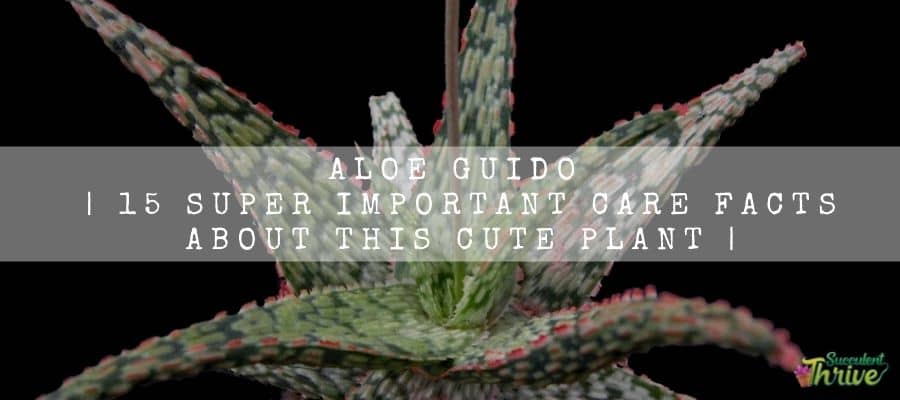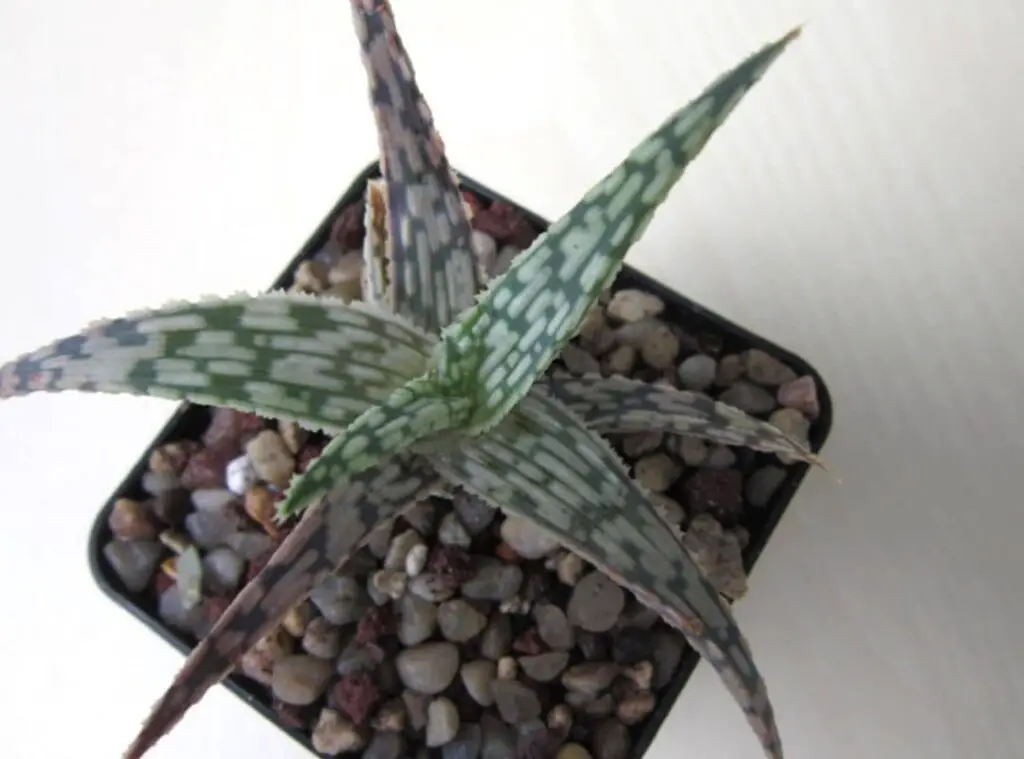Aloe Guido is yet another fantastic plant in the succulent world which is used to grow in drought conditions.
These are perennial succulents, and they consist of evergreen leaves. Aloe Guido is an aloe hybrid plant. Further their leaves form a rosette type.
You should provide the typical succulent growing conditions for them, and they will perform well given that you provide all these conditions.
If you are excited to own one of these stunning Aloe Guido plants, keep reading this article as I am sure it will be very useful for you.

How do I identify Aloe Guido?
Aloe Guido’s leaves form a rosette as aforesaid. The prominent color of the leaves would be pale green. Further they consist of white elongated dashes from bottom to the top of the leaves.
Their rosettes would be short and form in a tidy manner. The white elongated dashes give them a fabric patterned leaf look.
As such anybody would fall in love with this unusual and the stunning foliage. Their leaves’ tips would be more fringed.
Aloe Guido usually grows in clumps. They could survive in extreme heat conditions once they are well established.
In addition to aforesaid features, you could identify the Aloe Guido plants from the way they flower too. Literally Aloe Guido would produce flowers in salmon color.
Their flowering season would usually be from summer to fall. You could spot them forming in delicate spikes. Moreover, Aloe Guido flowers tend to take a look of a bell shape.
They would reach a maximum of 6 inches in height and 8 inches in width.
Size of the plant
Aloe Guido’s height would be usually around 6 inches whereas their width would be somewhere around 8 inches.
Growth rate
Aloe Guido usually grows in an upright manner. Further they are renowned as a slow growing set of plants.
One look care guide
| Botanical Name | Aloe Guido |
| Common Name | Aloe ‘Guido’ |
| Plant Type | Succulent |
| Mature Size | 6 inches in height / 8 inches in width |
| Sun Exposure | Full Sunlight to Partial sunlight |
| Soil Type | Well-draining sandy |
| Soil pH | ph. around 7.0-8.5 |
| Bloom Time | Summer to Fall |
| Flower Color | Salmon color |
| Hardiness Zones | USDA hardiness zones 9-11. |
| Toxicity | Mild |
| Average price | 5 USD |
How do you take care of Aloe Guido?
Light Requirement
Aloe Guido ‘s lighting requirement is quite similar to the rest of other succulents. Literally they will survive well if you expose them to full sunlight for a half day, preferably in the morning hours.
They can survive in partial shade during the rest of the day. It is important that you supply them with adequate sunlight levels since that will help them to keep their vibrant colors.
If you fail to provide them with the required sunlight, that will badly affect the plant’s growth.
So, when you grow them indoors, you need to place them near a bright sunny window spot as it could possibly be the place to locate them when you grow them indoors.
Temperature and humidity
Aloe Guido are tropical plants. Having said that if you live in colder weather conditions you may grow them as fine houseplants.
The minimum temperature they could thrive in would be 25 degrees Fahrenheit.
On the other hand they are quite used to growing in extremely drought tolerant weather conditions, and they could survive in those conditions well.
Is it cold hardy?
Aloe Guido are usually not frost hardy plants. However, they could be frost hardy only up to 25 degrees Fahrenheit only.
As such if you expect any temperatures which could get lower than that, you need to first grow them in containers which you could easily bring indoors.
That way you could protect these plants from frost conditions. If by any chance, you expose them to extreme winter conditions, that could badly impact on the plant’s growth.
USDA Hardiness Zone
Aloe Guido prefers to grow in USDA hardiness zones 9-11.
Watering Requirement
You need to make sure that you are watering them appropriately when taking care of these plants.
These plants usually grow in hot and dry weather conditions, and you should be extra careful to avoid over watering these beloved plants.
Refrain in supplying them with over water as it could cause the plant’s health to deteriorate.
Best is to apply the soak and dry method when watering them so that you can avoid any potential over-watering situation.
Literally you need to water the soil thoroughly and let them wither. You need to commence watering them only when their soil is dry.
In addition to that, you need to ensure you are growing them in a pot which has a draining hole in the bottom so that the excess water could move through.
Moreover, ensure that you are growing them in a well-draining soil mix too. That will make sure that the excess water is not retained in the pot.
Soil Requirement Type / pH
Aloe Guido would prefer to have a ph. around 7.0-8.5 in their soil mix. It needs to be an acidic to neutral soil mix.
Just as with the other succulents, Aloe Guido would also thrive well in a soil medium which has excellent drainage.
Ideally you could go ahead and plant them in a cactus soil mix or in a succulent soil mix which you can acquire easily from the stores.
Further you may consider adding sand, gravel or even any stone so that it could better the draining of the soil mix.
If you manage to provide them with a right soil mix which fulfills the aforesaid requirements that will help the plants to grow vigorously.

Flowering and Fragrance
As explained in the beginning of the article, Aloe Guido would usually flower in Autumn and in Summer. Those blooms would be in salmon color.
Moreover, they would tend to take a look at the bell shape as well. They would arise from delicate flower spikes. It would be so pleasing to watch them in their full blossom.
Pot size Potting and Repotting
The best pot material to grow these plants would be one made of porous material. As such Terracotta pots would perfectly fit in with these plants.
Further there should be a draining hole in the bottom of the pot too. Unless it would retain excess moisture within the pot and cause for root rot.
When it comes to repotting, you do not need to repot them quite often. Further, you may repot them once you purchase them from stores.
To do that, you should first take out the plant from the pot. Next check whether the plant is healthy and whether you could spot any rotten or damaged parts of the plant.
If there are any you need to get rid of them and later plant them in a well-draining soil mix. When you plant them, ensure that you are growing them in the same depth as they were initially planted.
Where to Plant
You need to plant them in a place where they can gain adequate sunlight levels. However, you need to be mindful to grow them in a well-draining soil mix.
Fertilizer and time of year
Succulents in general are not thoroughly dependent on fertilizers and these plants are no different to them.
However, you may consider feeding them as the plant’s growth would be benefitted from that. You may proceed with a fertilizer like a balanced fertilizer to feed them and you could use them once a month when they are in their active growing season.
Dormancy
Aloe Guido are dormant in winter.
Can be toxic to pets
In general Aloe plants contain mildly harmful chemicals. Therefore, always be careful handling this plant. Do not let your pet or baby to eat aloe leaves.
Handling the plant
As this can be mildly toxic, you need to be careful when handling this plant. Wear gloves, arm length shirts (or other cloth) to avoid any kind of contamination.
Common bugs and illnesses
Aloe Guido could come across bacterial and fungal diseases and they could create so much trouble for these plants.
If you over water them and if you do not grow them in a well-draining soil mix, that will make the plants vulnerable to such diseases.
Moreover, root rot is another major concern that they would go through, and it could be a real menace for the survival of these plants.
You could commonly spot this in soggy soil. In addition to that, they may come across issues such as fungal stem rot, soft and leaf rot too.
Special Care tips
Aloe Guido are easy-care plants. However, all you have to fulfil their main growing requirements.
Literally you need to water them properly, expose them for full sunlight to partial sunlight and finally grow them in a well-draining soil mix.
As long as you fulfil these requirements, they could grow vigorously and flourish. Further as aforesaid you need to do necessary steps to safeguard these plants from frost conditions .
Apart from all these, you need to keep inspecting these plants on a constant basis.
When you do this, it will allow you to see whether the plant is growing healthy or whether there are any early signs of any upcoming issues.
Apart from this, ensure that you are keeping the surrounding area clean and untidy too. If you fail to do that, those places would be perfect breeding places for pests.
How to propagate Aloe Guido
You could use their stem cuttings and offsets to conduct propagation of these plants.
If you proceed with the stem cutting propagation method, you simply have to snip an etiolated stem part and let them develop calluses for a few days.
Once it is completed, you could dip those cuttings in a rooting medium and grow them in a well-draining soil mix.
Conclusion
Before wrapping this up, trust you are now aware of how to grow an Aloe Guido plant properly and on the way of propagating them as well.
To sum up, as long as you take care of these plants well, they will flourish and grow to be such stunning sets of plants that anybody would fall in love with.
If these facts have made you so excited to have one of these, try starting gardening them and share the experiences with us as well.
Read Next Aloe Crosby’s Prolific | 14 Care Facts You Would Love | Aloe Blizzard Succulent Care | 14 Not So Bizarre Facts | Aloe Snowstorm Care | 15 Super Amazing Facts |
